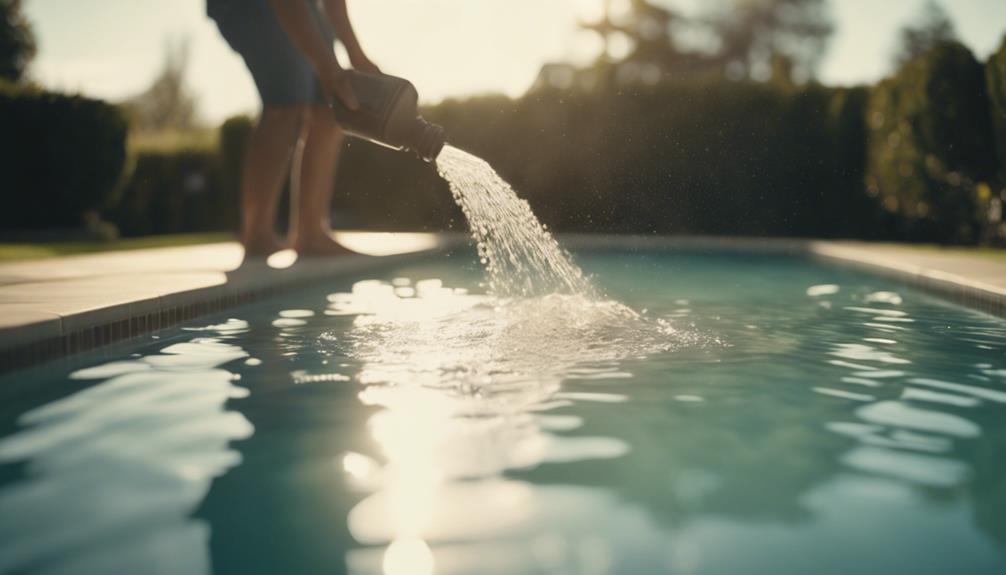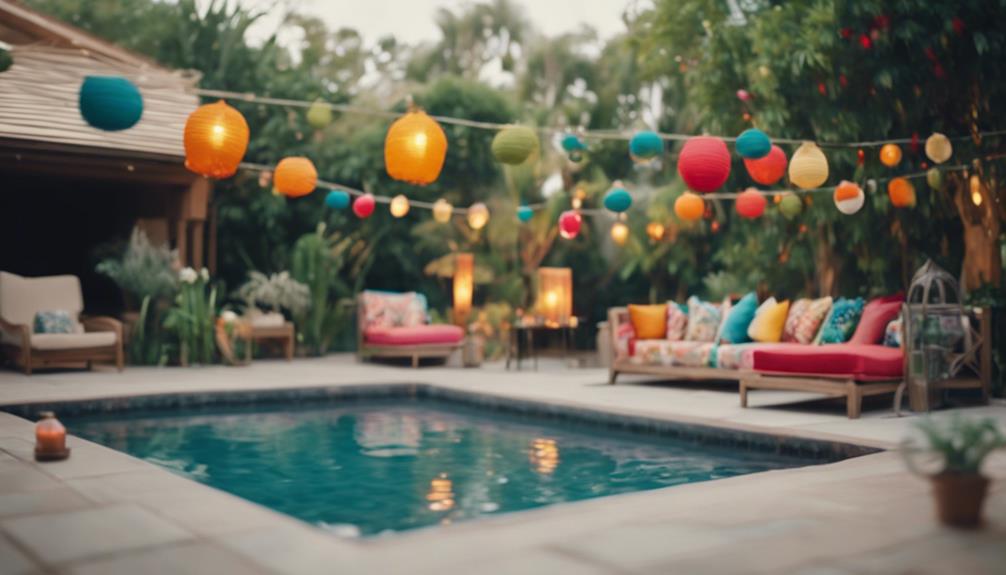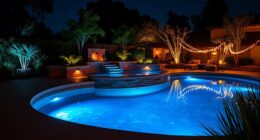Enhance your outdoor space with natural swimming pools for an invigorating experience. Utilize biological filters and plant life for clean, balanced water. Design elements include fresh water, decorative aesthetics, and sustainable ecosystems. Wildlife integration attracts beneficial organisms and maintains aquatic balance. Regular maintenance guarantees water quality and equipment longevity. Consider initial investment, long-term savings, and environmental benefits when planning. Safety regulations and fencing are essential for pool safety. Explore these ideas further for a harmonious blend of nature and relaxation.
Key Takeaways
- Incorporate plant-based filtration systems for natural water purification.
- Design with decorative pond elements for visual appeal.
- Integrate separate filter ponds, waterfalls, and decks for a unique look.
- Include diverse plant life to enhance biodiversity and ecosystem balance.
- Create a sustainable and visually stunning outdoor space with a natural swimming pool design.
Benefits of Natural Swimming Pools
Natural swimming pools provide an invigorating and rejuvenating swimming experience, benefiting both your health and the environment. These pools use biological filters and plant life to maintain water quality, eliminating the need for harsh chemicals. By mimicking natural ecosystems, natural swimming pools create a balanced environment that supports a wide range of wildlife and promotes biodiversity.
Not only do they offer an energizing dip, but they also serve as a sustainable ecosystem within your backyard. Compared to traditional chlorinated pools, natural swimming pools require lower maintenance costs, saving you money in the long run. The use of biological filters not only reduces chemical pollution but also conserves water resources.
Additionally, the energy-efficient filtration systems of natural pools contribute to eco-friendly practices, minimizing the environmental impact associated with traditional swimming pools. Embrace the benefits of a natural swimming pool and enjoy a healthier, more sustainable swimming experience.
Design Elements for Natural Pools

Design elements for natural pools incorporate fresh water and biological filters to create a chemical-free swimming experience while integrating decorative pond aesthetics. These pool design ideas often include separate filter ponds, waterfalls, streams, pergolas, and decks, adding a unique touch to your outdoor space.
The plant life within natural pools is essential, sometimes occupying an area equal to or larger than the swimming zone. This not only enhances the ecosystem but also promotes biodiversity. Additionally, regeneration plants play an important role in the filtration process, ensuring that the water remains clean and clear without the need for harsh chemicals.
Whether you opt for a small dip pool or a larger swimming pond, natural pools offer a sustainable and eco-friendly alternative to traditional chlorine pools. By incorporating water features and lush plant life, you can create a serene and visually stunning oasis in your backyard that both you and the environment will appreciate.
Wildlife Integration in Pool Design

You can create a wildlife-friendly pool by incorporating habitat-friendly features like rocks, logs, and shallow areas for creatures to access.
Plant-based filtration systems not only clean the water naturally but also provide a habitat for beneficial organisms like snails and insects.
Habitat-Friendly Pool Features
Integrating wildlife-friendly features into your pool can enhance the ecosystem and attract beneficial organisms. By incorporating habitat-friendly pool features into your natural swimming pool design, you create a welcoming environment for various wildlife and contribute to a healthier ecosystem compared to traditional chlorinated pools.
Here are four ways these features can benefit your natural pool:
- Attracting Wildlife: Aquatic plants and diverse vegetation provide shelter and food sources, attracting dragonflies, insects, amphibians, and other beneficial organisms that help regulate the ecosystem.
- Maintaining Balance: The presence of plants, insects, snails, and amphibians in natural pools contributes to maintaining a balanced aquatic habitat by supporting nutrient cycles and ecosystem functions.
- Mosquito Control: Natural pools with dragonflies and moving water help control mosquito populations by providing habitats for mosquito predators and deterring larvae.
- Regulating Nutrient Cycles: Organisms like Daphnia play an important role in regulating nutrient cycles within natural pools, contributing to water quality and ecosystem health.
Plant-Based Filtration Systems
Utilizing plant-based filtration systems in your natural swimming pool design enhances water purification and promotes a balanced ecosystem through the integration of aquatic plant life. These systems, incorporating aquatic plants like water lilies and cattails, play an essential role in filtering impurities and maintaining water clarity in your swimming pool. By harnessing the natural filtration capabilities of these plants, harmful substances are removed, creating a healthier and more sustainable environment for both you and the wildlife that may visit.
The presence of diverse aquatic plant species not only aids in purifying the water but also supports nutrient absorption and oxygenation, important for a thriving ecosystem. This integration of plant-based filtration systems in your swimming pool design not only enhances the natural beauty of the area but also attracts beneficial wildlife such as insects, frogs, and birds, contributing to a harmonious and balanced ecosystem within your pool.
Attracting Local Wildlife
Attracting local wildlife to your natural swimming pool can be achieved through thoughtful design and ecosystem maintenance. To enhance wildlife integration in your pool, consider the following tips:
- Promote Biodiversity: Incorporate a variety of plant life, insects, snails, and amphibians to create a balanced ecosystem that supports different wildlife species.
- Encourage Mosquito Predators: Attract mosquito predators like dragonflies to control mosquito populations naturally, reducing the need for chemical interventions.
- Utilize Moving Water: Implement water features that create movement in your pool to deter mosquito larvae and contribute to a mosquito-free environment.
- Support Amphibians: Create habitats that cater to amphibians, such as frogs and toads, which play an important role in regulating the ecosystem by consuming insects and maintaining balance.
Maintenance Tips for Natural Pools
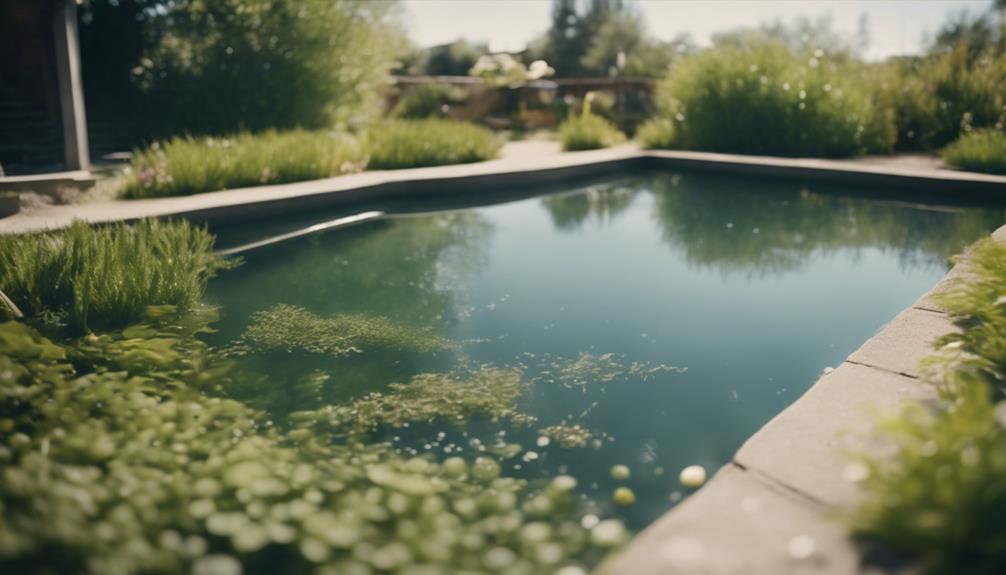
To keep your natural pool in top condition, make sure to regularly clean and balance chemicals.
Winterizing your pool is essential, especially in colder climates, to prevent any damage.
Remember to monitor equipment and address any issues promptly to maintain the beauty and functionality of your natural pool.
Water Filtration Systems
Regular maintenance of water filtration systems in natural pools is essential to guarantee ideal water quality and ecosystem balance. To guarantee your natural swimming pool functions efficiently, follow these maintenance tips:
- Regular Inspection: Check the water filtration system frequently to identify any clogs or issues that may affect its performance.
- Adjustment of Filtration Levels: Monitor and adjust the filtration system settings based on water quality tests to maintain peak filtration and ecosystem balance.
- Cleaning Routine: Regularly clean the filtration system components, such as the skimmer and pump, to prevent debris buildup and ensure proper water circulation.
- Professional Maintenance: Consider scheduling periodic professional maintenance to assess the overall condition of the water filtration system and address any potential problems proactively.
Plant Care Essentials
For peak plant health and a thriving natural pool ecosystem, prioritize regular pruning and maintenance of aquatic plants in your swimming pond. By keeping a close eye on water quality parameters like pH levels and nutrient concentrations, you can guarantee the vitality of your aquatic plants.
Regularly removing debris from the surface not only prevents clogging of filtration systems but also maintains water clarity, enhancing the overall aesthetics of your natural pool.
Maintaining a balanced ecosystem is essential for the sustainability of your swimming pond. Regulate plant growth and nutrient levels to optimize the function of your natural pool. Additionally, periodic checks on pump and filtration systems are necessary to uphold proper water circulation and filtration efficiency.
Cost Considerations for Natural Pools
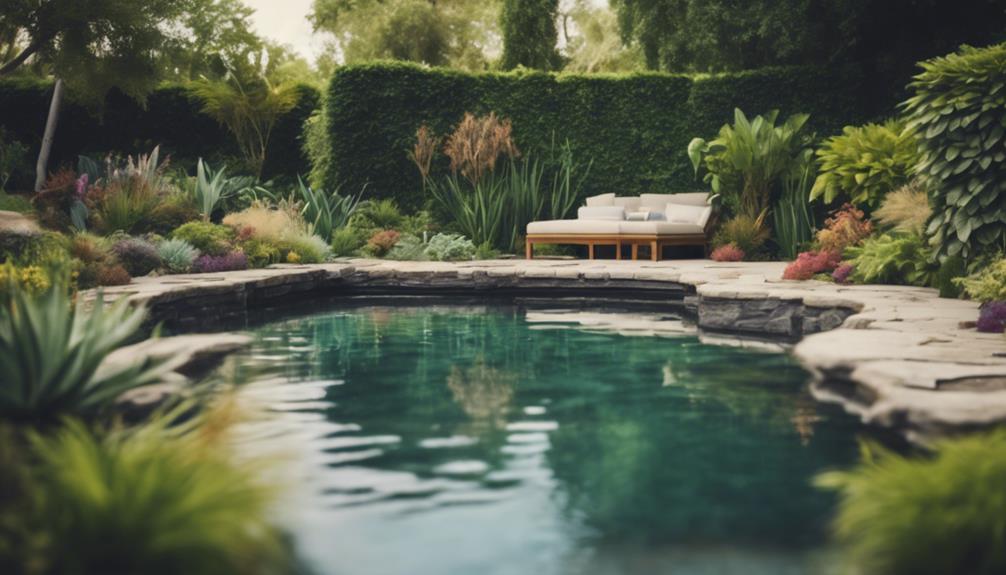
Considering the cost of natural pools can range from $60,000 to over $175,000 depending on various factors such as size, design, and features. When planning to build a natural pool, keep in mind the following cost considerations:
- Two-Pool System: Constructing separate pools for swimming and filtration can impact the overall cost considerably.
- Long-Term Maintenance Savings: While the initial investment for a natural pool might be higher, savings in long-term maintenance costs are achieved due to the absence of routine chemical treatments.
- Environmental Benefits: Natural pools offer environmental advantages, such as a chemical-free swimming experience, contributing to a healthier environment and supporting biodiversity.
- Pond Liner: The quality and type of pond liner used in the construction of a natural pool can influence the overall cost and durability of the pool structure.
Safety Regulations for Natural Pools
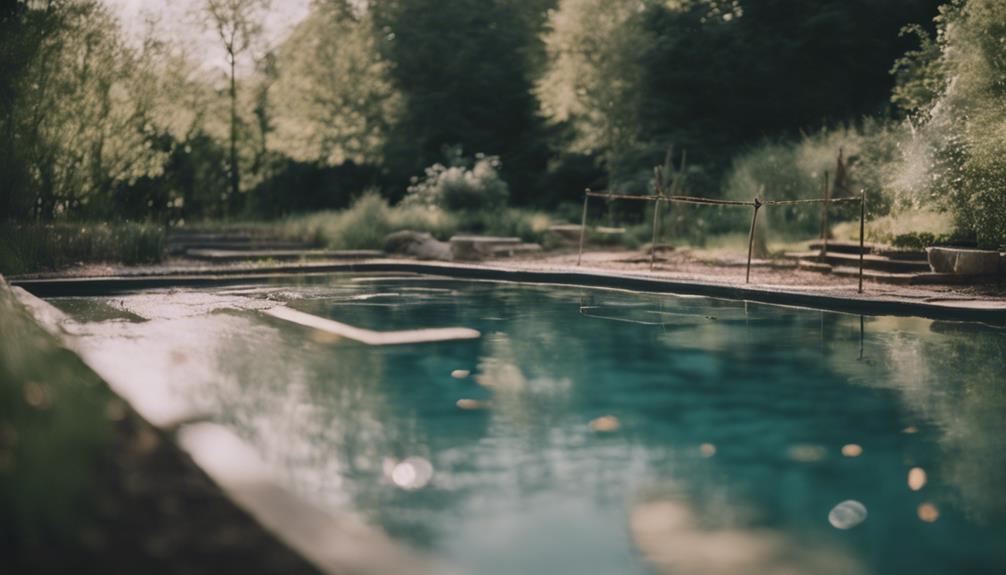
When building a natural pool, it's important to adhere to safety regulations to guarantee a secure swimming environment for all users. Safety regulations for natural pools may vary by location and must comply with local building codes and guidelines.
Proper fencing around natural pools is essential to prevent unauthorized access and ensure safety for children and pets. Depth markers should be clearly visible in natural pools to indicate water depth and promote safe swimming practices.
Installing safety covers or alarms on natural pools can provide an added layer of protection and prevent accidents. Regular maintenance and inspection of equipment like pumps and filtration systems are essential for ensuring a safe swimming environment in natural pools.
Frequently Asked Questions
How to Make a Swimming Pool Look Natural?
To make a swimming pool look natural, incorporate rocks, native plants, and a freeform shape. Add a waterfall for tranquility. Use earthy tones and organic shapes in the design. Blend the pool with its surroundings seamlessly.
What Is the Cheapest Way to Build a Natural Swimming Pool?
For the cheapest natural swimming pool, consider DIY construction. Costs range from $10,000 to $70,000, influenced by design complexity. Maintenance levels vary, akin to gardening. Implement energy-efficient heating methods to lower operational expenses.
Do Natural Pools Need Chemicals?
You don't need chemicals in natural pools. They rely on plants and filters for cleanliness. Say goodbye to red eyes and skin irritation. Embrace an eco-friendly oasis that supports wildlife and creates a balanced ecosystem.
Are Natural Pools More Expensive?
Alright, here's the scoop: Natural pools might have a higher upfront cost compared to traditional ones, but in the long run, they can save you money due to lower maintenance expenses.
What Makes Natural Swimming Pools Different from Traditional Ones?
Natural swimming pools, unlike traditional ones, prioritize ecological balance and sustainability. With a focus on using natural filtration processes and organic materials, new swimming pool ideas encourage a more harmonious coexistence with the environment. This results in a more serene and natural swimming experience compared to conventional pools.
Conclusion
To wrap up, natural swimming pools offer a distinctive and eco-friendly alternative to traditional chlorine pools. With their combination of beauty and sustainability, these pools can provide a rejuvenating escape right in your own backyard.
So, if you're looking to take a dip in style and harmony with nature, consider investing in a natural swimming pool. Who knew staying cool could be so chic and environmentally friendly?


